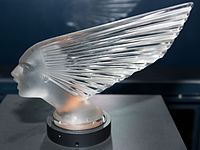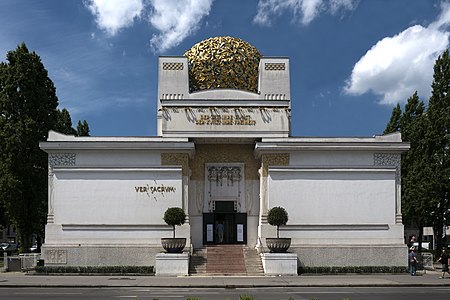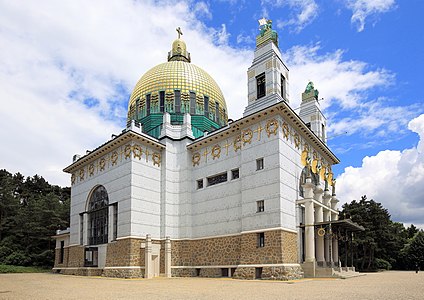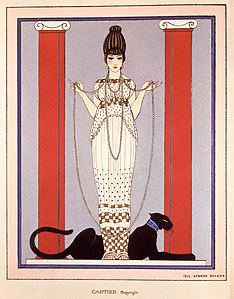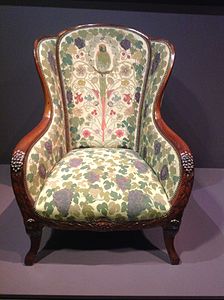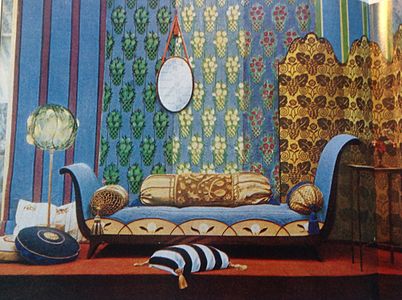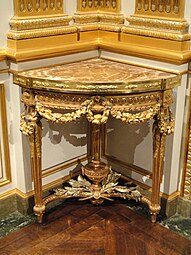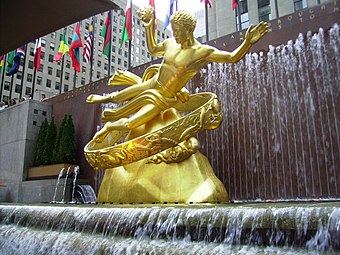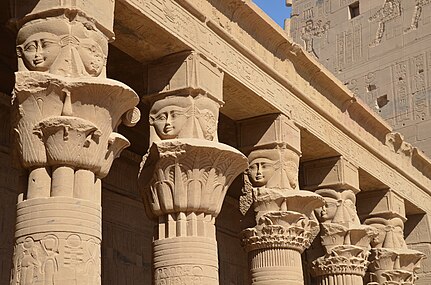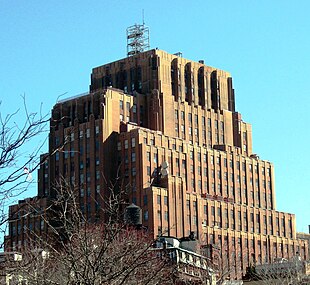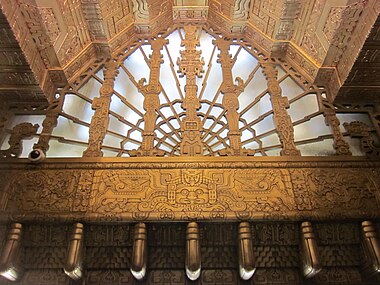
A | B | C | D | E | F | G | H | CH | I | J | K | L | M | N | O | P | Q | R | S | T | U | V | W | X | Y | Z | 0 | 1 | 2 | 3 | 4 | 5 | 6 | 7 | 8 | 9
This article may be in need of reorganization to comply with Wikipedia's layout guidelines. (August 2023) |
Top to bottom: Chrysler Building in New York City (1930); poster for the Chicago World's Fair by Weimer Pursell (1933); and Victoire hood ornament by René Lalique (1928) | |
| Years active | c. 1910s–1950s |
|---|---|
| Location | Global |
Art Deco, short for the French Arts décoratifs (lit. 'Decorative Arts'),[1] is a style of visual arts, architecture, and product design, that first appeared in Paris in the 1910s (just before World War I),[2] and flourished in the United States and Europe during the 1920s to early 1930s. Through styling and design of the exterior and interior of anything from large structures to small objects, including how people look (clothing, fashion, and jewelry), Art Deco has influenced bridges, buildings (from skyscrapers to cinemas), ships, ocean liners, trains, cars, trucks, buses, furniture, and everyday objects including radios and vacuum cleaners.[3]
Art Deco got its name after the 1925 Exposition internationale des arts décoratifs et industriels modernes (International Exhibition of Modern Decorative and Industrial Arts) held in Paris.[4] Art Deco combined the styles of early 20th century Modernist avant-garde, with the fine craftsmanship and rich materials of French historic design, but also sometimes with motifs taken from non-Western cultures. From its outset, Art Deco was influenced by the bold geometric forms of Cubism and the Vienna Secession; the bright colours of Fauvism and of the Ballets Russes; the updated craftsmanship of the furniture of the eras of Louis XVI and Louis Philippe I; and the exoticized styles of art from China, Japan, India, Persia, ancient Egypt and Maya.
During its heyday, Art Deco represented luxury, glamour, exuberance, and faith in social and technological progress. The movement featured rare and expensive materials, such as ebony and ivory, and exquisite craftsmanship. It also introduced new materials such as chrome plating, stainless steel and plastic. In New York, the Empire State Building, Chrysler Building, and other buildings from the 1920s and 1930s are monuments to the style.
In the 1930s, during the Great Depression, Art Deco gradually became more subdued. A sleeker form of the style, called Streamline Moderne, appeared in the 1930s, featuring curving forms and smooth, polished surfaces.[5] Art Deco was a truly international style, but its dominance ended with the beginning of World War II and the rise of the strictly functional and unadorned styles of modern architecture and the International Style of architecture that followed.[6][7]
Etymology
Art Deco took its name, short for Arts Décoratifs, from the International Exhibition of Modern Decorative and Industrial Arts held in Paris in 1925,[4] though the diverse styles that characterised it had already appeared in Paris and Brussels before World War I.
Arts décoratifs was first used in France in 1858 in the Bulletin de la Société française de photographie.[8] In 1868, the Le Figaro newspaper used the term objets d'art décoratifs for objects for stage scenery created for the Théâtre de l'Opéra.[9][10][11] In 1875, furniture designers, textile, jewellers, glass-workers, and other craftsmen were officially given the status of artists by the French government. In response, the École royale gratuite de dessin (Royal Free School of Design), founded in 1766 under King Louis XVI to train artists and artisans in crafts relating to the fine arts, was renamed the École nationale des arts décoratifs (National School of Decorative Arts). It took its present name, ENSAD (École nationale supérieure des arts décoratifs), in 1927.
The actual term art déco did not appear in print until 1966, in the title of the first modern exhibition on the subject, held by the Museum of Decorative Arts in Paris, Les Années 25 : Art déco, Bauhaus, Stijl, Esprit nouveau, which covered a variety of major styles in the 1920s and 1930s.[12] The term was then used in a 1966 newspaper article by Hillary Gelson in The Times (London, 12 November), describing the different styles at the exhibit.[13]
Art Deco gained currency as a broadly applied stylistic label in 1968 when historian Bevis Hillier published the first major academic book on it, Art Deco of the 20s and 30s.[3] He noted that the term was already being used by art dealers, and cites The Times (2 November 1966) and an essay named Les Arts Déco in Elle magazine (November 1967) as examples.[14] In 1971, he organized an exhibition at the Minneapolis Institute of Arts, which he details in his book The World of Art Deco.[15][16]
In its time, Art Deco was tagged with other names, like style moderne, Moderne, modernistic or style contemporain, and was not recognized as a distinct and homogenous style.[7]
Origins
New materials and technologies
New materials and technologies, especially reinforced concrete, were key to the development and appearance of Art Deco. The first concrete house was built in 1853 in the Paris suburbs by François Coignet. In 1877 Joseph Monier introduced the idea of strengthening the concrete with a mesh of iron rods in a grill pattern. In 1893, Auguste Perret built the first concrete garage in Paris, then an apartment building, house, then, in 1913, the Théâtre des Champs-Élysées. The theatre was denounced by one critic as the "Zeppelin of Avenue Montaigne", an alleged Germanic influence, copied from the Vienna Secession. Thereafter, the majority of Art Deco buildings were made of reinforced concrete, which gave greater freedom of form and less need for reinforcing pillars and columns. Perret was also a pioneer in covering the concrete with ceramic tiles, both for protection and decoration. The architect Le Corbusier first learned the uses of reinforced concrete working as a draftsman in Perret's studio.[17]
Other new technologies that were important to Art Deco were new methods in producing plate glass, which was less expensive and allowed much larger and stronger windows, and for mass-producing aluminium, which was used for building and window frames and later, by Corbusier, Warren McArthur, and others, for lightweight furniture.
Vienna Secession and Wiener Werkstätte (1897–1912)
The architects of the Vienna Secession (formed 1897), especially Josef Hoffmann, had a notable influence on Art Deco. His Stoclet Palace, in Brussels (1905–1911), was a prototype of the Art Deco style, featuring geometric volumes, symmetry, straight lines, concrete covered with marble plaques, finely-sculpted ornament, and lavish interiors, including mosaic friezes by Gustav Klimt. Hoffmann was also a founder of the Wiener Werkstätte (1903–1932), an association of craftsmen and interior designers working in the new style. This became the model for the Compagnie des arts français, created in 1919, which brought together André Mare, and Louis Süe, the first leading French Art Deco designers and decorators.[18]
-
Church of St. Leopold in Vienna by Otto Wagner (1903–1907)
-
Austrian Postal Savings Bank in Vienna by Wagner (1904–1912)
-
Detail of the Stoclet Palace's façade, made of reinforced concrete covered with marble plaques
Society of Decorative Artists (1901–1945)
The emergence of Art Deco was closely connected with the rise in status of decorative artists, who until late in the 19th century were considered simply artisans. The term arts décoratifs had been invented in 1875[citation needed], giving the designers of furniture, textiles, and other decoration official status. The Société des artistes décorateurs (Society of Decorative Artists), or SAD, was founded in 1901, and decorative artists were given the same rights of authorship as painters and sculptors. A similar movement developed in Italy. The first international exhibition devoted entirely to the decorative arts, the Esposizione Internazionale d'Arte Decorativa Moderna, was held in Turin in 1902. Several new magazines devoted to decorative arts were founded in Paris, including Arts et décoration and L'Art décoratif moderne. Decorative arts sections were introduced into the annual salons of the Sociéte des artistes français, and later in the Salon d'Automne. French nationalism also played a part in the resurgence of decorative arts, as French designers felt challenged by the increasing exports of less expensive German furnishings. In 1911, SAD proposed a major new international exposition of decorative arts in 1912. No copies of old styles would be permitted, only modern works. The exhibit was postponed until 1914; and then, because of the war, until 1925, when it gave its name to the whole family of styles known as "Déco".[19]
-
Table and chairs by Maurice Dufrêne and carpet by Paul Follot at the 1912 Salon des artistes décorateurs
-
Lady with Panther by George Barbier for Louis Cartier (1914). Display card commissioned by Cartier shows a woman in a Paul Poiret gown.
Parisian department stores and fashion designers also played an important part in the rise of Art Deco. Prominent businesses such as silverware firm Christofle, glass designer René Lalique, and the jewellers Louis Cartier and Boucheron began designing products in more modern styles.[20][21] Beginning in 1900, department stores recruited decorative artists to work in their design studios. The decoration of the 1912 Salon d'Automne was entrusted to the department store Printemps,[22][23] and that year it created its own workshop, Primavera.[23] By 1920 Primavera employed more than 300 artists, whose styles ranged from updated versions of Louis XIV, Louis XVI, and especially Louis Philippe furniture made by Louis Süe and the Primavera workshop, to more modern forms from the workshop of the Au Louvre department store. Other designers, including Émile-Jacques Ruhlmann and Paul Follot, refused to use mass production, insisting that each piece be made individually. The early Art Deco style featured luxurious and exotic materials such as ebony, ivory and silk, very bright colours and stylized motifs, particularly baskets and bouquets of flowers of all colours, giving a modernist look.[24]
Salon d'Automne (1903–1914)
-
Art Deco armchair made for art collector Jacques Doucet (1912–13)
-
Display of early Art Deco furnishings by the Atelier français at the 1913 Salon d'Automne from Art et décoration magazine (1914)
At its birth between 1910 and 1914, Art Deco was an explosion of colours, featuring bright and often clashing hues, frequently in floral designs, presented in furniture upholstery, carpets, screens, wallpaper and fabrics. Many colourful works, including chairs and a table by Maurice Dufrêne and a bright Gobelin carpet by Paul Follot were presented at the 1912 Salon des artistes décorateurs. In 1912–1913 designer Adrien Karbowsky made a floral chair with a parrot design for the hunting lodge of art collector Jacques Doucet.[25] The furniture designers Louis Süe and André Mare made their first appearance at the 1912 exhibit, under the name of the Atelier français, combining polychromatic fabrics with exotic and expensive materials, including ebony and ivory. After World War I, they became one of the most prominent French interior design firms, producing the furniture for the first-class salons and cabins of the French transatlantic ocean liners.[26]
The vivid hues of Art Deco came from many sources, including the exotic set designs by Léon Bakst for the Ballets Russes, which caused a sensation in Paris just before World War I. Some of the colours were inspired by the earlier Fauvism movement led by Henri Matisse; others by the Orphism of painters such as Sonia Delaunay;[27] others by the movement known as Les Nabis, and in the work of symbolist painter Odilon Redon, who designed fireplace screens and other decorative objects. Bright shades were a feature of the work of fashion designer Paul Poiret, whose work influenced both Art Deco fashion and interior design.[26][28][29]
Théâtre des Champs-Élysées (1910–1913)
-
Théâtre des Champs-Élysées by Auguste Perret at 15, avenue Montaigne, Paris (1910–1913). Reinforced concrete gave architects the ability to create new forms and bigger spaces.
-
La Danse, bas-relief on the façade of the Théâtre des Champs-Élysées by Antoine Bourdelle (1912)
-
Interior of the Théâtre des Champs-Élysées, with Bourdelle's bas-reliefs over the stage
-
Dome of the Theater, with Art Deco rose design by Maurice Denis
The Théâtre des Champs-Élysées (1910–1913), by Auguste Perret, was the first landmark Art Deco building completed in Paris. Previously, reinforced concrete had been used only for industrial and apartment buildings, Perret had built the first modern reinforced-concrete apartment building in Paris on rue Benjamin Franklin in 1903–04. Henri Sauvage, another important future Art Deco architect, built another in 1904 at 7, rue Trétaigne (1904). From 1908 to 1910, the 21-year-old Le Corbusier worked as a draftsman in Perret's office, learning the techniques of concrete construction. Perret's building had clean rectangular form, geometric decoration and straight lines, the future trademarks of Art Deco. The décor of the theatre was also revolutionary; the façade was decorated with high reliefs by Antoine Bourdelle, a dome by Maurice Denis, paintings by Édouard Vuillard, and an Art Deco curtain by Ker-Xavier Roussel. The theatre became the venue for many of the first performances of the Ballets Russes.[30] Perret and Sauvage became the leading Art Deco architects in Paris in the 1920s.[31][32]
Cubism
-
Design for the façade of La Maison Cubiste (Cubist House) by Raymond Duchamp-Villon (1912)
-
Detail of the entrance of La Maison Cubiste at the 1912 Salon d'Automne
-
Le Salon Bourgeois, designed by André Mare inside La Maison Cubiste, in the decorative arts section of the 1912 Salon d'Automne. Metzinger's Femme à l'Éventail can be seen hanging on the left wall.
-
Cubist villa at 3-49 Libušina Street, Vyšehrad (Prague), by Josef Chochol (1912–13). Chochol was one of three Czech architects (members of the Mánes Union of Fine Arts), with Pavel Janák and Josef Gočár, influenced by Cubism.

The art movement known as Cubism appeared in France between 1907 and 1912, influencing the development of Art Deco.[30][27][28] In Art Deco Complete: The Definitive Guide to the Decorative Arts of the 1920s and 1930s Alastair Duncan writes "Cubism, in some bastardized form or other, became the lingua franca of the era's decorative artists."[28][33] The Cubists, themselves under the influence of Paul Cézanne, were interested in the simplification of forms to their geometric essentials: the cylinder, the sphere, the cone.[34][35]
In 1912, the artists of the Section d'Or exhibited works considerably more accessible to the general public than the analytical Cubism of Picasso and Braque. The Cubist vocabulary was poised to attract fashion, furniture and interior designers.[27][29][35][36]
In the Art Décoratif section of the 1912 Salon d'Automne, an architectural installation was exhibited known as La Maison Cubiste.[37][38] The façade was designed by Raymond Duchamp-Villon. The décor of the house was by André Mare.[39][40] La Maison Cubiste was a furnished installation with a façade, a staircase, wrought iron banisters, a bedroom, a living room—the Salon Bourgeois, where paintings by Albert Gleizes, Jean Metzinger, Marie Laurencin, Marcel Duchamp, Fernand Léger and Roger de La Fresnaye were hung.[41][42][43] Thousands of spectators at the salon passed through the full-scale model.[44]
The façade of the house, designed by Duchamp-Villon, was not very radical by modern standards; the lintels and pediments had prismatic shapes, but otherwise the façade resembled an ordinary house of the period. For the two rooms, Mare designed the wallpaper, which featured stylized roses and floral patterns, along with upholstery, furniture and carpets, all with flamboyant and colourful motifs. It was a distinct break from traditional décor. The critic Emile Sedeyn described Mare's work in the magazine Art et Décoration: "He does not embarrass himself with simplicity, for he multiplies flowers wherever they can be put. The effect he seeks is obviously one of picturesqueness and gaiety. He achieves it."[45] The Cubist element was provided by the paintings. The installation was attacked by some critics as extremely radical, which helped make for its success.[46] This architectural installation was subsequently exhibited at the 1913 Armory Show, New York City, Chicago and Boston.[27][35][47][48][49] Thanks largely to the exhibition, the term "Cubist" began to be applied to anything modern, from women's haircuts to clothing to theater performances."[46]
The Cubist influence continued within Art Deco, even as Deco branched out in many other directions.[27][28]
Cubism's adumbrated geometry became coin of the realm in the 1920s. Art Deco's development of Cubism's selective geometry into a wider array of shapes carried Cubism as a pictorial taxonomy to a much broader audience and wider appeal. (Richard Harrison Martin, Metropolitan Museum of Art)[50]
Influences
Pre-World War I European styles
-
Ballets Russes influences – Drawing of the dancer Vaslav Nijinsky, by Paris fashion artist Georges Barbier (1913)
-
Rococo – Chest of drawers, by Jacques Dubois (1750–1755), various wood types and gilt bronze mounts, Waddesdon Manor, Buckinghamshire, UK
-
Rococo influences – Commode, by Paul Iribarne Garay (c. 1912), mahogany and tulip wood frame, slate top, green-tinted shagreen upholstery, ebony knobs, base and garlands, Museum of Decorative Arts, Paris
-
Beaux Arts influences – Avenue de Versailles no. 70-72, Paris, "Modern" decor in an established typology, designed by Paul Delaplace and sculpted by Jean Boucher (1928)
-
Louis XVI style – Corner table, by Jean-Francois-Therese Chalgrin (1770), gilded wood, Corcoran Gallery of Art, Washington, D.C.
-
Louis XVI style influences – Dressing table and chair set, by Paul Follot (1919), marble and wood encrusted, lacquered and gilded, Musée d'Art Moderne de Paris
-
Neoclassical influences – Prometheus, a stylised Art Deco update of classical sculpture, by Paul Manship (1936), gilded bronze, Rockefeller Center, New York City
-
Art Nouveau influences – Sinuous curves on the façade of Avenue Montaigne no. 26, Paris, by Louis Duhayon and Marcel Julien (1937)[51]
Art Deco was not a single style, but a collection of different and sometimes contradictory styles. In architecture, Art Deco was the successor to (and reaction against) Art Nouveau, a style which flourished in Europe between 1895 and 1900, and coexisted with the Beaux-Arts and neoclassical that were predominant in European and American architecture. In 1905 Eugène Grasset wrote and published Méthode de Composition Ornementale, Éléments Rectilignes,[52] in which he systematically explored the decorative (ornamental) aspects of geometric elements, forms, motifs and their variations, in contrast with (and as a departure from) the undulating Art Nouveau style of Hector Guimard, so popular in Paris a few years earlier. Grasset stressed the principle that various simple geometric shapes like triangles and squares are the basis of all compositional arrangements. The reinforced-concrete buildings of Auguste Perret and Henri Sauvage, and particularly the Théâtre des Champs-Élysées, offered a new form of construction and decoration which was copied worldwide.[53]
Ancient and non-European civilizations
-
Ancient Egyptian art – Vegetal capitals in the courtyard of the Isis Temple, Philae, Egypt, unknown architect (380 BC–117 AD)[54]: 30
-
Egyptian influences – Dress with lotus flowers inspired by Ancient Egyptian decoration, by Jenny (couturier) and Lesage (embroiderer) (1925), silk, metallic thread, and crocheted embroidery, Musée Galliera, Paris
-
Mesopotamian art – Ziggurat of Ur in Tell el-Muqayyar, Dhi Qar Province, Iraq, unknown architect (21st century BC)[55]
-
Mesopotamian influences – Western Union Building (Hudson Street no. 60) in New York City, by Voorhees, Gmelin and Walker (1928–1930)
-
Pre-Columbian art (in this case Maya) – Yaxchilan Lintel 24 (702 AD), limestone, British Museum, London[56]
-
Pre-Columbian influences (in this case Maya) – Interior detail of 450 Sutter Street in San Francisco, California, by Timothy L. Pflueger (1929)
-
Zdroj:https://en.wikipedia.org?pojem=Art_deco_architecture
Text je dostupný za podmienok Creative Commons Attribution/Share-Alike License 3.0 Unported; prípadne za ďalších podmienok. Podrobnejšie informácie nájdete na stránke Podmienky použitia.
Antropológia
Aplikované vedy
Bibliometria
Dejiny vedy
Encyklopédie
Filozofia vedy
Forenzné vedy
Humanitné vedy
Knižničná veda
Kryogenika
Kryptológia
Kulturológia
Literárna veda
Medzidisciplinárne oblasti
Metódy kvantitatívnej analýzy
Metavedy
Metodika
Text je dostupný za podmienok Creative
Commons Attribution/Share-Alike License 3.0 Unported; prípadne za ďalších
podmienok.
Podrobnejšie informácie nájdete na stránke Podmienky
použitia.
www.astronomia.sk | www.biologia.sk | www.botanika.sk | www.dejiny.sk | www.economy.sk | www.elektrotechnika.sk | www.estetika.sk | www.farmakologia.sk | www.filozofia.sk | Fyzika | www.futurologia.sk | www.genetika.sk | www.chemia.sk | www.lingvistika.sk | www.politologia.sk | www.psychologia.sk | www.sexuologia.sk | www.sociologia.sk | www.veda.sk I www.zoologia.sk



